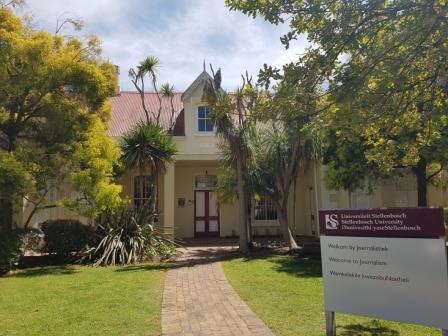
The University of Stellenbosch's Department of Journalism has a rich and colourful history that echoes back to the beginning of 1978. This is the year in which newspaper stalwart and retired editor of Die Burger, Prof Piet Cillié, introduced himself to the first ever journalism class to have studied at Protea House. Acting on a proposal made to him by Ebbe Dommisse, the then news editor at Die Burger, Cillié was inspired to launch a journalism degree at his alma mater, the University of Stellenbosch, which he modelled closely on the world-renowned Columbia School of Journalism in New York. Just like its American counterpart, the department focuses exclusively on a number of different postgraduate degrees and it is currently the only specialised postgraduate training institution for journalists in South Africa.
The Department of Journalism is conveniently situated on campus in Protea House, a renovated Edwardian building and national monument. Students are provided with an unparalleled working environment as far as scenic beauty and ambience are concerned, allowing them to pursue their studies with the zest it deserves.
.jpg)
As part of the honours level course, the BA Hons Journalism, aspiring media professionals from diverse academic and cultural backgrounds are afforded the opportunity to spend a whole year gaining invaluable practical journalistic skills, as well as being exposed to the ethical, technological, marketing, managerial, sociological and historical basis of the media. This is in stark contrast to the past, when newspapers scarcely believed in any formal training for their rookie reporters, simply throwing them into the deep end where they either had to sink or swim. Since then, the situation has changed dramatically and an academic qualification is now a virtual necessity for any prospective journalist.
When Cillié founded the department in 1978, it was one of his biggest goals to help establish journalism in South Africa as a respected and professional occupation. This ideal was carried forward after Cillié's retirement at the end of 1983 by his successor and ex-editor of Beeld, Prof. Johannes Grosskopf. Grosskopf also witnessed how the international communications revolution shook the world and the department had to adapt accordingly in order to survive. Once beloved and trustworthy typewriters were swept aside and replaced by computer screens and keyboards. After Grosskopf's retirement at the end of 1993 to travel the world, his successor, Prof George Claassen, has seen to it that the department has remained in step with the latest technological advances that could be of benefit to journalists. Under Claassen's leadership, the department has placed a high premium on computer literacy, as well as Internet literacy. Students receive intensive training on how to utilise the Internet for research purposes. His successor, Prof Lizette Rabe, also an alumnus of the first class of 1978, emphasises the need for multi-skilled journalists for a dynamic, morphing multi-media world where converging technology is the name of the game.
In 1995 the students started to publish their own magazine, Stellenbosch Journalism Insight. This was replaced in 2002 by the launching of a new yearly publication, Stellenbosch Media Forum, commonly known by the students as SMF. The honours class also started to produce LIP in 2006 to report on the annual US Woordfees. In 2017 LIP changed into a publication aimed at promoting and reporting on media freedom.

In 2017 the students launched their own news website,
MatieMedia with the guidance of Rykie van Reenen Fellow, Andre Gouws. The Department also has an active presence on various social media platforms.

